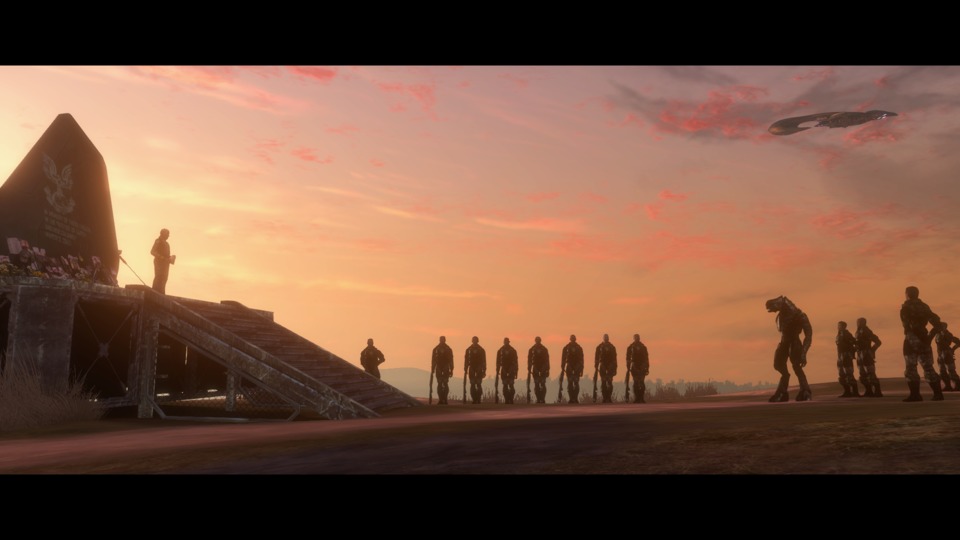The Great Journey Finishes the Fight - Halo 3
By Darth_Navster 0 Comments
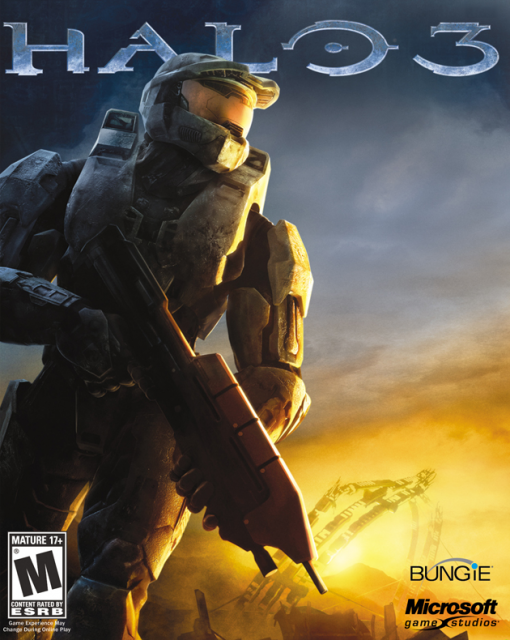
Welcome to the end! Or the midpoint, or the end of the beginning, I’m not really sure. In any case, this edition of the The Great Journey wraps up the Covenant-Human war. For those who missed previous entries, I am playing through each campaign in the Master Chief Collection and writing up my thoughts on each one. The entry on Halo: Combat Evolved, can be found here, and the one on Halo 2 can be found here. Now, forward unto the trilogy’s conclusion!
Halo 3, being the franchise’s debut on the venerable Xbox 360, seeks to wrap up the Master Chief’s story with the most bombastic campaign the series has yet seen. As part of the Master Chief Collection, the game isn’t as eye-catching as the fully remastered Halo 2 Anniversary and has to impress on its own merits. Going into Halo 3 I was fully expecting a letdown in terms of visuals compared to the previous games. However, I was pleasantly surprised at how good the game looks at 1080p and 60 frames per second. Sure, the textures don’t look as sharp as Halo 2’s Xbox One powered surfaces, but Halo 3 just goes to show that there’s more to a game’s visuals than just graphics. The animations, movement speed, and cinematography in Halo 3 take full advantage of the generational leap to make a more visually cohesive game than previous entries. But what really makes the game sing is the doubling down on what Halo does best; scale.
It’s almost a given for any franchise moving to a new generation of hardware to go big. While some franchises can misfire going this route, Halo distinctly benefits from it. The first Halo was a brilliant exercise in using scale to vary the campaign and emphasize different aspects of the gameplay, and Halo 2 elaborated on this concept. But Halo 3 just blows the doors off and brings scale to the forefront. From the very start of the game, we see the Master Chief streak across the Earth’s sky, descending from the Covenant ship he stowed aboard at the end of the previous game. We hear Cortana narrate about how she got paired with the Chief, referencing the out-of-game fiction that up until this point was never acknowledged in the games proper. This marks a change in philosophy in Halo’s world-building. Throughout Halo 3, there is a greater emphasis on the larger Halo canon, with the Chief being referred to as John on occasion and sly mentions of Dr. Catherine Halsey, a major figure in the canon and an important character in future games. It’s a welcome change for lore nerds like myself, and it’s one of the major legacies that future games take from Halo 3. That all being said, even if the outside canon references go over your head there is still much in this campaign to satisfy most players.

After a brief reunion with Sergeant Johnson and a rough introduction with the Arbiter, the Chief is off to the races fighting Covenant in a jungle. Right off the bat the game establishes a more earthy tone, with lots of greens and browns to act as a contrast to the grey and purple that characterized major portions of the previous games. Combat feels great, especially with the 60fps framerate making everything look buttery smooth. The Brutes make up for their lackluster Halo 2 debut by becoming more multi-faceted to fight against. Sure, them being outfitted with shields makes them similar to the Elites, who you are now allied with, but they still retain some differences compared to their Covenant rivals. Brutes still have the ability to charge at you after sustaining some damage and they still have their own arsenal. In addition to the mainstay Brute shot, the big apes now have the spiker and mauler to complement their loadout. These weapons go a long way in making the campaign segments without human weapons far more enjoyable. The Brute weapons can take down unshielded enemies with ease, so there’s rarely a time where your only option is to juggle plasma pistols. The first level is relatively confined and makes for an excellent area to experiment with these new foes and their weapons, along with the rebalanced UNSC and Covenant arsenals. Just as you begin to feel comfortable with the new mechanics, however, the jungle gives way to more open human settlements to reintroduce the proper combat sandbox.
The human structures in Halo 3 are a far cry from Halo 2’s gleaming and futuristic New Mombasa. They are smaller and less built up, reflecting a society forced to go primitive as it stages a desperate guerrilla campaign against a much larger Covenant force. To that end fighting in these areas encourages the player to be tactical, hopping in and out of structures and picking off the Covenant here and there. The game further emphasizes creative combat by introducing equipment, which are one-off activated devices such as the always useful bubble shield or the more situational gravity lift. I’m not the biggest fan of this addition and appreciate that the latest entries move away from equipment, but they can be fun when used on occasion. For the most part I ignored using equipment and it got me through fine on normal difficulty.
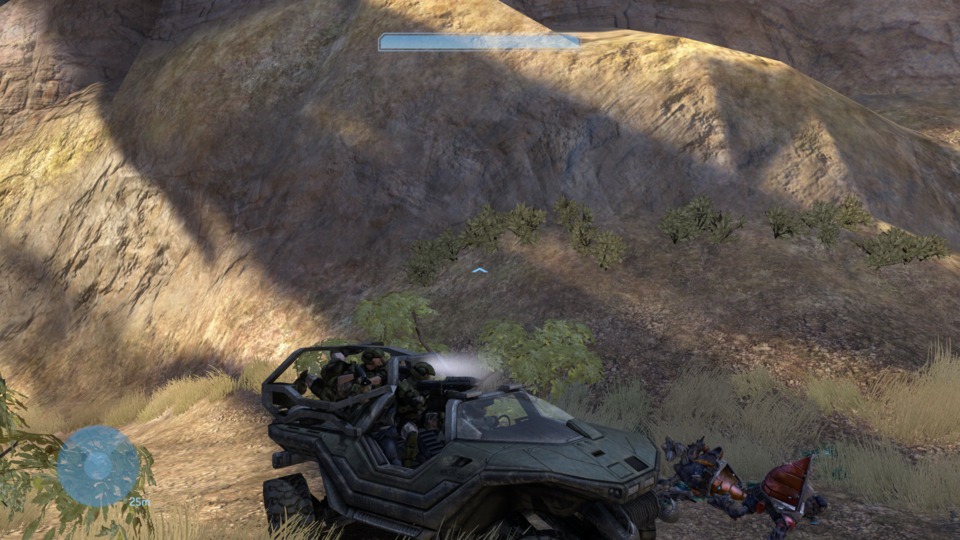
The rest of the game’s first half smartly stays on earth and focuses on the Chief and Arbiter seeking a way to punch a hole in the Covenant armada to strike at the final High Prophet and repel the invasion. This part of the game is almost uniformly great, with some massively open areas in which to test out Halo’s various vehicles. The existing vehicles all seem to handle better, with the Warthog in particular more stable and easier to maneuver. The new vehicles, especially the Brute Chopper and Mongoose are excellent additions that seem to be balanced perfectly with the previous stable. The game also expands on the Scarabs of Halo 2, but this time making the sequences with them more open and more varied in ways to take them down. The one mission that doesn’t feel as good comes early on and has you defending a human base from a Covenant assault. The idea behind the mission isn’t necessarily a bad one, in that you will be going back and forth fighting in a confined space not unlike a multiplayer map, but it drags on a bit too long and has a few annoying sections of too many enemies in too confined a space. But one mediocre mission isn’t enough to stall the momentum the first half of the campaign builds up.
The game reaches a turning point about mid-way through the story. The Covenant successfully open up a slipspace portal near earth and a Flood-infested ship comes through and promptly crashes into an earth city. It’s a major mood-swing in the narrative and the visuals change to reflect this. Gone are the lush greens and browns, with dark greys and blacks blotting out the sky. As the Chief heads into the city in hopes of containing the infection, the game builds up the tension by giving you glimpses of the new enemy without allowing you to engage them. This tension doesn’t last all that long, but builds up enough to make the first engagement with the Flood an exciting and slightly scary experience. The level is constructed in such a way to give the player plenty of space to keep enemies at a distance and get a feel for what weapons work well against them. Story-wise, the game’s B-plot starts coming to the fore. Throughout the campaign, the Chief has been experiencing hallucinations of Cortana, supposedly under the thumb of the Gravemind. While these visions seemed quite cryptic early on, they become clearer once the Flood enter the picture. It’s apparent that Cortana, or at least some part of her is close by, and as luck would have it the Chief finds a recording by the spunky AI deep in the bowels of the crashed Flood ship. This recording teases that Cortana has found a way to finally stop the Flood without destroying all other life. With few other options, the Chief, Arbiter, and a small fleet of human and Elite ships make their way through the portal in search of Cortana.
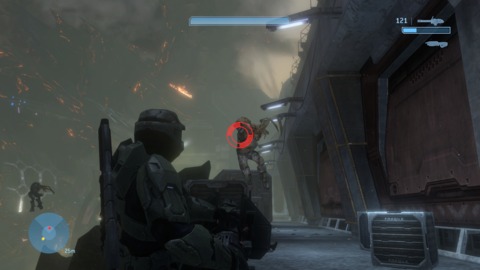
Unlike Halo 2, leaving the earth in Halo 3 doesn’t feel like a disappointment. Indeed, Halo 3 spends so much time on earth that checking out a different locale feels more like a fresh change of pace rather than a jarring transition. It also helps that the new location isn’t simply another Halo. When the human and Elite contingent pass through the portal, they are greeted by an altogether different piece of Forerunner technology, known as the Ark. It is here, well outside the Milky Way, that Halos are built. Unfortunately for our heroes, it is also under Covenant control. The Ark feels both alien and familiar at the same time. The installation is dotted with Forerunner architecture and one of the first tasks to complete is accessing the cartographer in order to locate the control room, similar to how the previous Halos operated. But at the same time the skybox is dominated by our home galaxy, a constant reminder of how far the Chief is from the planet he wishes to protect. In addition to the change in setting, the game continues to add new wrinkles into the gameplay. To that end we are introduced to the amazingly useful Hornet twin-rotor flying vehicle and always fun Spartan laser. The Hornet especially makes these missions enjoyable as the ability to hover in a stationary position while raining down bullets and rockets on enemies is endlessly empowering. In addition to this new flying death machine the game goes all out with vehicles, alternating between Warthog, Brute Chopper and Ghost segments, pitched Scorpion and Wraith battles, and aerial dogfights involving Banshees and Hornets. All of this culminates into a pulse-pounding battle with all of those vehicles and two Scarabs, and it is certainly a high point for the campaign. This part of the game culminates in the Chief and Arbiter finding and killing the High Prophet and stopping the Ark from activating the remaining Halos. Unfortunately, with the Covenant dealt with a new threat rises to take its place.
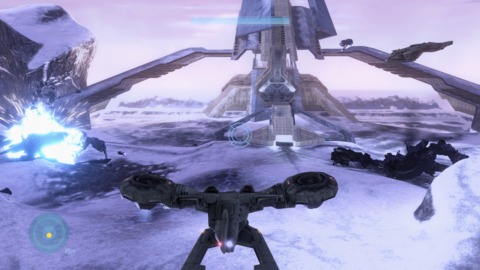
The final two missions of the game take quite a risk and focus exclusively on the Flood. Given the split reaction from the fanbase in previous Halos, the game could have easily gone off the rails here. While I would like to say that Halo 3 finally redeems the Flood’s checkered history, that isn’t necessarily the case. The penultimate mission, known as Cortana, has achieved a level of notoriety to rival the first Halo’s Library and it certainly earns its reputation. The level is an out and out slog that never seems to end. There are portions of the mission where you will be stuck fighting upstream against a river of Flood and making no forward progress. The winning strategy here is to camp out at a defensible location and take out enemies as they come to you, but this just destroys any momentum the game had going for it. Luckily, Halo 3 seems to be easier on normal difficulty than previous games so there are less cheap deaths to make the experience longer than it needs to be. After an interminably long period of rote combat, you finally make it to where Cortana is held captive and the story picks up with an emotional (by Halo standards) reunion. Unfortunately, the game squanders this relative high point by making the Chief fight his way out through where he came in. More Flood, more lame combat, and a blatant repeat of previously used content. Next mission please.
The final mission, aptly titled Halo, is a significant improvement right off the bat. You are placed in a wide open area with more than enough space to engage the Flood and it feels quite cathartic blowing up those bastards with minimal risk of dying. The objective here is to activate the Ark’s partially built Halo, thereby eradicating the remaining Flood, the Gravemind, and destroying the Ark and the various Halos’ capability to cleanse the galaxy. The first half of the mission is a straightforward fight through the Flood to the new Halo’s control room in order to activate it. The midpoint of the mission is an easy and fun “boss” battle with 343 Guilty Spark, the floating robot that seems to always be betraying you, and from there it’s off to the races as the Chief and Arbiter seek to get off the Ark before the new Halo activates.
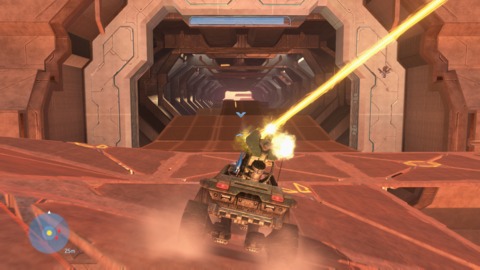
The final chase sequence is a perfect callback to the escape sequence in Halo: Combat Evolved, except with some improvements for the better. Unlike the last escape, the Chief is accompanied by the Arbiter, who gets on the mounted gun and mows down any enemies that dare to hinder their escape. Further to that, the escape path is far less constrained, allowing you to maneuver and avoid obstacles. Finally, the removal of a timer makes the escape feel more spur of the moment and exciting. The final ramp jump onto the starship Forward Unto Dawn feels appropriately awesome. It’s clear that Bungie did a lot of work to make this sequence feel great and it more than adequately serves as the culmination of the trilogy. However, as our heroes make their escape, the Forward Unto Dawn gets ripped apart, leaving the Master Chief and Cortana floating in space awaiting rescue that could be years away. The Arbiter, Elites, and remaining humans memorialize the fallen and it appears that a new day has dawned on the galaxy.
Without discounting the considerable steps taken in the previous games, Halo 3’s campaign is a significant improvement for the series. The game remains breathtakingly large and provides a near perfect execution of Halo’s combat mechanics. Despite a few rough spots, the game hits such high points that I can’t but outright love the overall experience. In 2007 Halo fans didn’t necessarily know that they would get more games in the franchise, so Halo 3 was seen as the last game in the Master Chief’s journey. Had that been the case, the game would have more than lived up to it being the final chapter in a storied franchise. As it stands now, it smartly expands the combat sandbox and its lessons still informs the series to this day. I’m looking forward to continuing this series of write-ups, but I’m particularly glad I managed to get as far as Halo 3. It really is an incredible game, and a fantastic summation of what makes Halo great.
